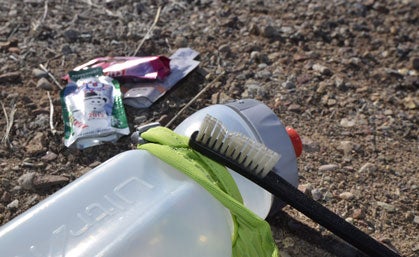Shoes, Check. Gels, Check. Toothbrush?

How mid-race fuel may be affecting your pearly whites…
Plantar fasciitis, stomach cramping, black toenails—these are common maladies afflicting trail runners. But not on most runners’ radar is another potential casualty of our eccentric sport—our teeth. We often rely on high-sugar snacks to keep us fueled on long training runs or races, and these can be a recipe for cavities and tooth decay.
Trail runners frequently rely on quick-carb gels, chews and sports drinks for sustenance during races. Unfortunately, diets high in carbohydrates provide nutrient content for cavity-causing bacteria to flourish in the mouth.
Says dental hygienist and sports nutritionist Sunny Blende, “Research shows that the biofilm, the thin layer of organisms that cover the surface of your teeth, formed in the presence of sucrose [sugar] present a situation ripe for demineralization of enamel.” Because carbohydrate residue remains in the mouth for up to an hour after ingestion, runners consuming fuel at relatively regular intervals risk keeping a constant supply of cavity-causing bacteria in their mouths.
How difficult is it to avoid the rotten effects of a high-sugar diet on the trails? Runners Karl Meltzer, 45, of Sandy Utah, and Sophie Speidel, 50, of Charlottesville, Virginia, talked to us about the measures they take to preserve their dental health.
“I am sure to include a toothbrush and toothpaste in my drop bags,” said Speidel. Meltzer agreed that he, and runners like him, probably have an exceptionally high sugar intake—though said he felt able to negate these effects by brushing his teeth after long runs and seeing a dentist regularly.
The low-pH environment created by the simple carbohydrates runners ingest can be counteracted, however. Says Blende, “Neutralization occurs when the salivary buffer is restored, or the acidity counteracted with water. … Remineralization comes in the form of liquid calcium—found in a number of toothpastes and oral rinses.”
In a paper on the subject, she offered a series of suggestions to lower the impact of energy foods on our teeth:
- Have at least one extra water bottle solely for the purpose of swishing your mouth out.
- Brush (and maybe even floss) at the halfway point of any race over 50 miles.
- Consume sugar quickly, avoiding hard candies or bars that could freeze and require a lot of warming-up time before they are dissolved and digested.
- Be careful with gummy foods that tend to get stuck in between teeth.
- Regularly brush, floss and see a dentist to have your teeth cleaned.
Utah’s Wasatch 100 is well known for its investment in the well being of its runners’ mouths. Claude Grant, one of the race’s staff, told us, “The captain of our Brighton Lodge aid station is a local dentist and decided to offer toothbrushes with toothpaste already incorporated at his station.”
The giveaways have become a signature at Mile 75, though the original intention was a simple courtesy—the toothbrushes offer runners the joy of a clean mouth and fresh breath. They may be on to something.
Says Spiedel, “I like to brush my teeth after running all night—it plain feels good, and wakes me up!” Not to mention it may save you an unwanted trip to your dentist.